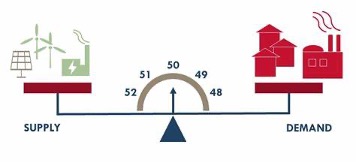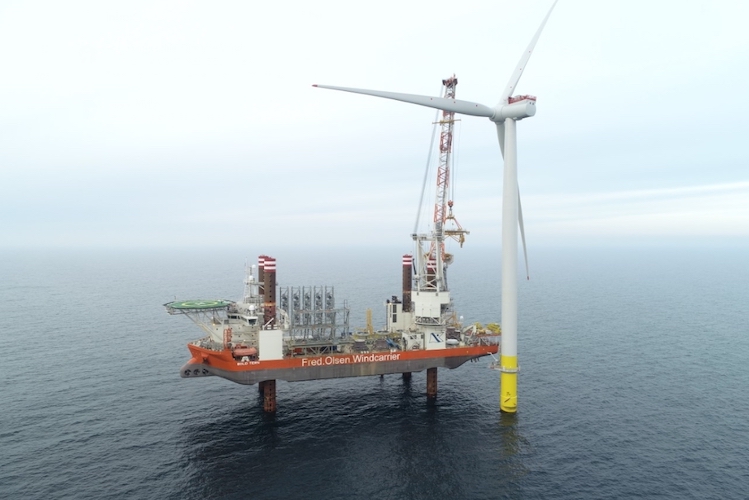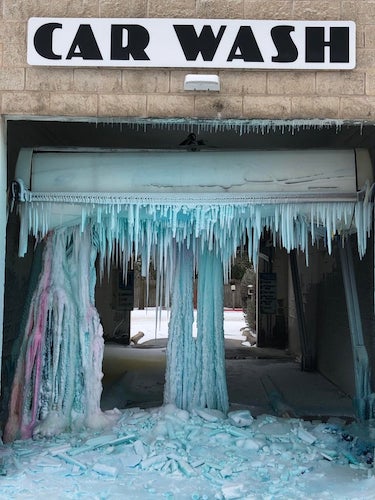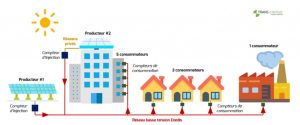The incidents that have occurred in Europe so far have been due to system stability problems in frequency and voltage. This takes on an important dimension as soon as the share of intermittent renewable energy production (solar and wind – EnRi) exceeds 30%. It is increased by the close integration of systems. System managers are not failing to draw lessons by feedback.
Problems have also been encountered in the world for other reasons, in particular due to the insufficiency of back-up and flexibility sources and insufficient anticipation of their availability (as in South Australia, Texas and California).
______
Incidents on electricity grids due to the presence of growing wind and solar PV capacities with intermittent production tend to recur in Europe, as in other regions of the world. Variable input renewable energies (VRE), pose two main security of supply problems for electrical systems. The first is the variability of their non-controllable production, which requires the development of complementary flexible means. The second is the fact that the rapid variations in VRE production create a problem for system stability in terms of frequency and voltage, a problem that takes on a significant dimension as soon as the share of VRE production exceeds the threshold of 20-30% of the annual energy[1]. We can recall that the stability of the frequency, 50 Hz in Europe (Figure 1), of the electrical system is currently ensured by the rotors of the thermal power plant alternators, i.e. nuclear and fossil fuels. Without them, how can this stability be ensured since the power converters associated with wind farms and photovoltaic power plants and used for their connection to the grid are inoperative?
To address the first type of problem, new sources of flexibility must be developed in coordination with the development of renewable energy capacities, including various types of storage (batteries, compressed air, pumped hydro storage (PHS) if sites exist), large-scale load shedding (particularly in the industrial consumption and electric vehicle recharging segments), power to Gas solutions (hydrogen production followed by methanation from hourly surplus MWh of renewable energy, to produce MWh by gas turbine in periods of deficit) and, in a more complex way, the increase of interconnections to take advantage of the “swarming” of renewable energy production and demand between countries and systems.
Will we have to wait for a large-scale blackout due either to a system stability problem or to the narrowness of the reserve margins due to the closure of controllable power plants and the lack of flexibility sources before we look the problem in the face, and give ourselves the means to encourage the development of flexibility sources, or even slow down the development of intermittent RE if flexibility does not follow? Let’s first look at the recent incidents in Europe and around the world, partly linked to the presence of large wind and solar units.

Figure 1: Stability of the power grid – [Source: https://www.aemo.com.au/newsroom/managing-frequency-in-the-power-system]
1. Lessons from incidents in Europe
They mainly concern system stability problems. On January 8, 2021, when intense cold weather caused a sharp increase in electricity demand in Europe, the continent’s power grid came close to a massive blackout due to very large south to north power flows with poorly anticipated effects. The highly integrated system from Lisbon to Istanbul, split in two as the northwest and southeast regions struggled to maintain the 50 hertz frequency. The problem originated in Croatia and caused outages at 200,000 homes and industrial sites across Europe, including France. Although this event was not directly related to renewable energy, it once again draws attention to the problems posed by the huge variations in production that grids must deal with. Incidents like this one are likely to become more frequent, as the problem is the reduction in controllable capacity. This results in gaps in system stabilization procedures that need to be filled. The report of the European Transmission System Operators (ENTSO-E) association pointed out that the large south-north European power flows on that day played a crucial role in the incident because the usual system stability margins were too small[2]. Therefore, safety calculations need to be increasingly accurate and conservative and Transmission Systems Operators (TSO) need to cooperate very closely at the regional and European levels to cope with sudden flows by calling on stability contributors in their regulatory area, as well as in neighboring countries.
The exchange of information plays a crucial role, as we can also see in the incident of November 4, 2006 with which the whole of Europe was close to a major blackout. More than 15 million households were plunged into darkness for hours. The incident was caused by a lack of anticipation and coordination between TSOs following the interruption of a high voltage line on the Ems River in Germany to allow a ship to pass through from a shipyard. The ensuing instability was sustained by the “tripping” of many wind turbines by their frequency protection in Germany. It was transmitted to the German networks and affected the French, Belgian and Dutch networks on one side and the Polish network on the other. Solutions were subsequently implemented by the grid operators, such as automatic grid separation, triggering of backup generation, demand shaving and, for wind turbines connected to the dispatch and distribution grids, more flexible automatic control by synchronous inverters.
Britain experienced a regional blackout on August 9, 2019, affecting 1.1 million consumers due to a sudden shutdown of the large Hornsea 1 offshore wind facility (Figure 2, 800 MW at the time) off the coast of East Yorkshire, which was combined with the “tripping” of a 640 MW gas-fired combined-cycle plant shortly after a lightning strike on an overhead transmission line in Cambridgeshire. At the same time, about 150 MW of smaller, distributed generation went offline and stopped producing as the frequency of the power grid dropped below 50 Hz[3]. The TSO activated backup generators to make up some of the shortfall to balance the system, but because there was not enough backup generation available, local grid operators automatically disconnected some consumers from the grid to avoid further system-wide disruption. To mitigate such risks in the future, National Grid Company is developing a frequency monitoring and control system to address the issues associated with the presence of increasing VRE capacity. It is expected to be operational by 2025[4].

Figure 2: Hornsea 1 wind turbine – [Source: https: //www.offshorewind.biz/2019/06/18/hornsea-one-turbines-halfway-there/]
2. Other “brown outs” in the world
The rotating load shedding during the August 2020 heat wave in California was due to a lack of storage capacity to back up VRE generation at the height of peak demand. This was also the case for the spectacular load shedding in Texas during the unusual cold snap of February 2021 (Figure 3), during which the shortfall in production from solar and wind power plants affected by anti-cyclonic conditions and freezing temperatures added to the shortfall in supply from gas-fired power plants via pipelines hampered by the very low temperatures. These usually provide the base load generation and were supposed to be sufficient to ensure the back up of wind and solar generation[5]. It should be noted that the wind capacity at the end of 2020 was 30 GW and the solar PV capacity was 1 GW, for a non-RE park of 95 GW, and provided 25% of the annual production that same year. But the availability of conventional power plants in any situation has been underestimated in the system operator’s and regulator’s expectations. It should also be noted that Texas is completely self-sufficient without interconnections with neighboring systems, so as not to be dependent on federal regulation.

Figure 3: Texas Cold Wave in 2021 – [Source: https: //www.demotivateur.fr/article/ces-16-photos-de-la-vague-de-froid-impressionnante-qui-touche-le-texas-vont-vous-donner-de-frissons-24086 – © SlammyDavisjr / Twitter]
3. Future problems in the Western European system
In the medium term, in Europe, we have the right to be concerned when we see the scheduled closures of coal and nuclear power plants in Germany, France, Belgium and elsewhere, which are supposed to be replaced by intermittent renewables without sufficient development of scheduled wind flexibility sources. A January 2021 France Stratégie report entitled “Quelle sécurité d’approvisionnement électrique en Europe à l’horizon 2030?” draws attention to the possibility of failures in European electricity systems, and in particular the French system, which is closely integrated physically and through markets with the six adjacent systems[6]. Very ambitious targets for the development of renewable energies have been set everywhere, and in particular in Germany, while solutions in terms of demand management and load shedding, storage capacities and, more generally, flexibility remain insufficiently developed and will remain so in the medium to long term.
In the 2020s, numerous closures of controllable power plants are planned, while the concrete consequences on the security of supply seem to be little taken into account, with the large-scale deployment of renewable energy units. The planned development of flexibility sources between now and 2035 is currently insufficient to back up intermittent generation on the desired scale once the closures are completed.
The France Stratégie report shows that in Germany, with the definitive phase-out of nuclear power in 2022 and the gradual phase-out of coal by 2038, which is still planned for early 2021, the capacity of controllable power plants will decrease from 100 GW to 80 GW by 2035, and the reserve margin will drop from 6 GW in 2020 with 91 GW for a peak demand of 85 GW to 88GW in 2035 with 87 GW of guaranteed power with storage and load shedding for a peak demand of 95 GW. This situation will undoubtedly worsen with the acceleration of closures decided by the coalition that came to power at the end of 2021, because in 2030 there should still be 17 GW of coal and lignite power plants, and 8 GW in 2035, out of the 29 GW at the end of 2021. The French situation is not comfortable either, based on the forecasted shutdown of controllable power plants and the ban on the construction of new fossil plants. The reserve margin provided by the controllable power plants, which is still 1.7 GW in 2025, becomes negative in 2030 with -5 GW, reaching -9 GW in 2035 with the currently planned storage and load shedding.
In fact, the more the interconnected system is extended, the more it becomes possible to benefit from complementarities between various production and consumption zones, in particular due to the low correlation between wind production between zones. Germany clearly plans to rely more on its neighbors, importing electricity through increasing interconnections, especially as it will accelerate the closure of its coal and lignite power plants. While it is currently a net exporter to Austria, Switzerland, Poland and the Netherlands, many parts of the continent could face electricity shortages when it stops exporting its surpluses on a regular basis. The ability to ensure security of supply in critical periods, particularly those of peak demand combined with low VRE production, thus becomes even more uncertain the more closely interconnected the systems are. When reserve margins are reduced, deficits in one system can lead to critical situations for neighbors who have sufficient reserves.
When closures are not coordinated between countries, how far can we rely on neighboring systems, especially if they no longer have reserve margins after the closure of controllable capacities and the insufficient development of flexibility sources in relation to that of renewable energies? This is underlined by the RTE and IEA report of January 2021 on the technical feasibility of a system with a high share of renewable energies in France: “The reasonable development of demand flexibility and the support of neighboring countries will no longer suffice (…) As of 2035, it will no longer be possible to continue to increase the share of renewable energies without developing flexibility in a very significant way.
This raises a serious problem of lack of coordination between EU Member States, which already have different energy and climate strategies, but it also refers to a lack of anticipation by each of them on the internal consequences of their choices. We trust in the development of green “Power to Gas” technologies to ensure flexibility if battery storage cannot develop at a good pace, and we trust in the integration of systems and markets to rely on other countries to ensure the guarantee of supply as a last resort.
In fact, everywhere, there is a tendency to rely on others, as was recently the case in February 2021 in Sweden, which is committed to a policy of closing its nuclear and oil-fired power plants. During a very recent cold snap that hampered the operation of wind turbines, it was forced to import electricity from its southern neighbors (Lithuania, Germany, Poland) which was usually produced by coal-fired power plants, which is a contradiction in terms of greenhouse gas emissions.
4. How to respond to these problems?
Let’s put aside the problems of real-time system management posed by the close integration of renewable energies; as we saw with the January 2021 incident, system managers are not failing to learn from feedback to improve their coordination and the transmission of information between them. They are working together withinENTSOE (figure 4) (European association for the cooperation of transmission system operators), in particular to improve network codes and procedures for transmitting information in real time.

Figure 4: ENTSO-E – [Source: https: //consultations.entsoe.eu/system-development/entso-e-tyndp2016-3rd-wp-scenarios/consult_view/]
4.1. The limits of market incentives
How can we invest in the development of flexibility sources to ensure a sufficient supply of system services and balancing services and to facilitate energy transfers through arbitrage? The task is difficult because the remuneration of system services such as balancing reserves or voltage system services by the market mechanisms that have been put in place is based on the principle of “opportunity gain”, i.e. what a given quantity of a given system service offered by a given supplier would allow to save at the time in question in the system. However, this remuneration does not include the capital cost of the equipment that provides these services. No player will invest on this basis in flexibility despite the growing need for system services, because their prices are very volatile, as are their additional revenues from daily or weekly arbitrage. Arbitrage on hourly electricity markets consists in taking advantage of price differences between hours of surplus production, when prices are low, and hours of supply-demand tension, when prices are highest, on a daily and weekly basis. Moreover, in the long run, the arbitrage revenues that can be anticipated will be uncertain and random because they depend on the competitors’ investments in storage facilities.
Some think that we could also expect very high exceptional hourly revenues (1000 €/MWh) for a few hours (instead of 50 €/MWh usually) on the energy market and on the balancing markets when there is a very tense situation, as it happened three times during the winter of 2020-21 in the United Kingdom where the TSO had to launch “alert notifications” to encourage operators to make additional offers, which it does in difficult contexts to cope with the possibility of unexpected decreases in VRE production. In this case, there were scheduled shutdowns of some nuclear reactors, a recent mothballing of two gas plants by private operators waiting for more suitable configurations, and a reduction in interconnection capacities. The UK TSO is confident that the price mechanism in the hourly electricity market is still sufficient to get through difficult times, with the notifications they send to operators leading them to offer balancing services at high prices, which is currently still sufficient. But these additional revenues do not really serve to attract investment in flexible equipment, but only to attract bids in tense times, which leads experts to lament that until there is a blackout, things will not change[7].
4.2. Recourse to long-term contracts with guaranteed income
One solution could come from the extension of “capacity mechanisms” to flexibility sources. These mechanisms were created in various European countries to provide additional remuneration per guaranteed MW available in critical periods, and not per MWh, to any equipment capable of ensuring that it can be available in critical periods, particularly during peak demand. In France, the only effect of the mechanism so far has been to postpone the closure of equipment and to develop load shedding and demand management. In principle, they should have encouraged the installation of state-of-the-art equipment such as fast-ramp combustion turbines. However, this has not happened, as the long-term revenues to be expected to make an investment profitable are uncertain. On the other hand, in countries such as the United Kingdom, where the mechanism is based on long-term guaranteed remuneration contracts for new installations, developments are real. There are even plans to expand the mechanism to include flexibility sources, including battery storage, pumped storage power plants (if the country still has sites available), demand-side management, and even new interconnections to take advantage of the overlapping nature of renewable energy and demand generation. The French mechanism should therefore be reformed in this sense, not to mention those of other European countries. Moreover, referring to the existing “remuneration supplement contracts” for wind and photovoltaic equipment, one could think of this type of simpler auction-based tendering mechanism for long revenue guarantee contracts for storage units, or even fast-ramp gas turbines using green hydrogen from electrolysis[8].
4.3. The need for long-term coordination between countries and systems
In any case, nothing seems to guarantee the security of supply in the medium and long term in the event of a cold and snowy winter in an anticyclonic situation with frost and no wind that would cover several countries, with long-lasting failures and not just a few hours, if each country continues its policy of developing renewable energies while relying on the others. It is essential to improve the coordination of these developments, the closing of controllable equipment and the implementation of new sources of flexibility. The very high level of integration of electrical systems and markets at the European level means that the electrical system must now be considered on this scale. Today, states plan at the national level, while relying increasingly on imports from their neighbors, without any coordination to guarantee the security of supply of the whole.
The situation is all the more worrying because, as shown in the France Stratégie report of 2021 cited above, the deficit of controllable capacity in Europe will increase in the coming years. Logically, a close long-term coordination should be put in place on the continent to guarantee the security of electricity supply in the integrated system, as exists for technical coordination in real time. The forecasting programs developed by ENTSO-E on a regular basis are not sufficient, as they are based on government announcements. However, there is no guarantee of stability in the policies of the States, which can decide to change their policies without consulting their neighbors. These changes are not the subject of real discussions between European energy ministers on issues of security of supply. Decisions to close nuclear power plants in Germany were taken in 2011 without consultation, as was the announcement in November 2021 by the new German coalition to close coal in 2030, instead of 2038 as initially planned, and to increase the share of renewables to 80% by that date instead of 55%. A real willingness to work together and harmonize between Member States would therefore be necessary, but we should probably not dream too much, as the domestic political concerns of each are so great.
Notes & References
Cover image. [Source : https://www.dailypioneer.com/2021/trending-news/massive-blackout-in-pakistan.html]
[1] IEA & RTE (2021). “Technical feasibility conditions and prerequisites for an electricity system with a high proportion of renewables by 2050”. February 2021. https://assets.rte-france.com/prod/public/2021-01/RTE-AIE_synthese%20ENR%20horizon%202050_FR.pdf
[2] ENSTOE (2021). Final report on the separation of the Continental Europe power system on 8 January 2021. July 2021. Continental Europe Synchronous Area Separation on 08 January 2021 / ICS Final Report / Executive Summary (azureedge.net)
[3] Watt Logic (2019). What caused the UK’s power blackout and will it happen again? August 2019. http://watt-logic.com/2019/08/12/august-2019-blackout/
[4] OFGEM (2020). “9 August 2019 power outage report. Recommendations”. January 2020 https://www.ofgem.gov.uk/sites/default/files/docs/2020/01/9_august_2019_power_outage_report.pdf
[5] Joshua W. Busby et alii (2021). Cascading risks: Understanding the 2021 winter blackout in Texas. Energy Research & Social Science. Volume 77, July 2021, 102106. https://www.sciencedirect.com/science/article/pii/S2214629621001997?via%3Dihub
[6] France Stratégie (Etienne Beeker) (2021). What security of electricity supply in Europe by 2030? January 2021 n°99. Note d’analyse 99 – Quelle sécurité d’approvisionnement électrique en Europe à horizon 2030 (strategie.gouv.fr)
[7] Bloomberg (2021). U.K. Electricity Grid Creaks Under Repeated Winter Pressure. January 2021. https://www.bloomberg.com/news/articles/2021-01-06/u-k-electricity-grid-creaks-under-repeated-winter-pressure
[8] RTE (2021). Energy Futures 2050. Key Findings. https://assets.rte-france.com/prod/public/2021-12/Futurs-Energetiques-2050-principaux-resultats.pdf





